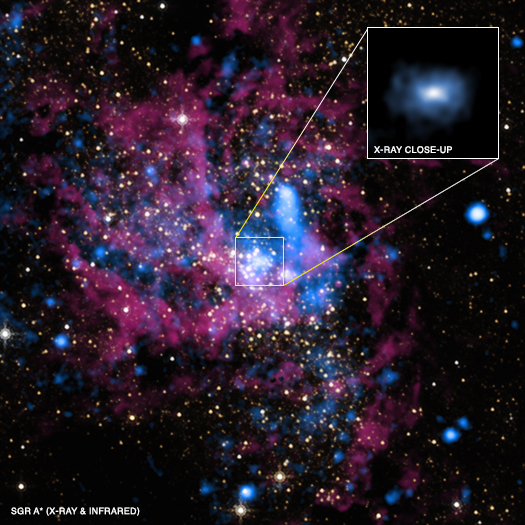For Release: August 29, 2013
NASA
Astronomers using NASA's Chandra X-ray Observatory have taken a major step in explaining why material around the giant black hole at the center of the Milky Way Galaxy is extraordinarily faint in X-rays. This discovery holds important implications for understanding black holes.
New Chandra images of Sagittarius A* (Sgr A*), which is located about 26,000 light-years from Earth, indicate that less than 1 percent of the gas initially within Sgr A*'s gravitational grasp ever reaches the point of no return, also called the event horizon. Instead, much of the gas is ejected before it gets near the event horizon and has a chance to brighten, leading to feeble X-ray emission.
These new findings are the result of one of the longest observation campaigns ever performed with Chandra. The spacecraft collected five weeks' worth of data on Sgr A* in 2012. The researchers used this observation period to capture unusually detailed and sensitive X-ray images and energy signatures of super-heated gas swirling around Sgr A*, whose mass is about 4 million times that of the sun.
"We think most large galaxies have a supermassive black hole at their center, but they are too far away for us to study how matter flows near it," said Q. Daniel Wang of the University of Massachusetts at Amherst, who led a study published Thursday in the journal Science. "Sgr A* is one of very few black holes close enough for us to actually witness this process."
The researchers found that the Chandra data from Sgr A* did not support theoretical models in which the X-rays are emitted from a concentration of low-mass stars around the black hole. Instead, the X-ray data show the gas near the black hole likely originates from winds produced by a disk-shaped distribution of young massive stars.
"This new Chandra image is one of the coolest I’ve ever seen," said co-author Sera Markoff of the University of Amsterdam in the Netherlands. "We're watching Sgr A* capture hot gas ejected by nearby stars, and funnel it in towards its event horizon."
To plunge over the event horizon, material captured by a black hole must lose heat and momentum. The ejection of matter allows this to occur.
"Most of the gas must be thrown out so that a small amount can reach the black hole", said co-author Feng Yuan of Shanghai Astronomical Observatory in China. "Contrary to what some people think, black holes do not actually devour everything that’s pulled towards them. Sgr A* is apparently finding much of its food hard to swallow."
The gas available to Sgr A* is very diffuse and super-hot, so it is hard for the black hole to capture and swallow it. The gluttonous black holes that power quasars and produce huge amounts of radiation have gas reservoirs much cooler and denser than that of Sgr A*.
The event horizon of Sgr A* casts a shadow against the glowing matter surrounding the black hole. This research could aid efforts using radio telescopes to observe and understand the shadow. It also will be useful for understanding the effect orbiting stars and gas clouds may have on matter flowing toward and away from the black hole.
NASA's Marshall Space Flight Center in Huntsville, Ala., manages the Chandra program for NASA's Science Mission Directorate in Washington. The Smithsonian Astrophysical Observatory controls Chandra's science and flight operations from Cambridge, Mass.
The paper is available online at:
http://arxiv.org/abs/1307.5845
For Chandra images, multimedia and related materials, visit:
http://www.nasa.gov/chandra
For an additional interactive image, podcast, and video on the finding, visit:
http://chandra.si.edu
Media contacts:
J.D. Harrington
Headquarters, Washington
202-358-5241
j.d.harrington@nasa.gov
Megan Watzke
Chandra X-ray Center, Cambridge, Mass.
617-496-7998
mwatzke@cfa.harvard.edu




Visitor Comments (4)
The way how stars and galaxies work, It s good to stretch our minds and study outer space where trillions of the stars a smallness does erase. With light-years in the billions we cannot realize the vastness of our space that all around us lies. It is the star dust that makes me wonder how the endless time itself was created. But I still have a question to ask, from planets to stars to black holes, is it true that the Andromeda Galaxy is moving toward us?
Posted by Ivan Sanchez Valencia on Wednesday, 01.10.18 @ 19:44pm
I do not understand much of this but I liked the blue and magenta blobs all spotted with intense white, thanks.
Posted by Torsten Borg on Saturday, 11.16.13 @ 09:41am
Thanks for making such wonderful stuff as this available to those of us who are fascinated by the existence of all the known and unknown "celestial bodies"? and of the myriad implications to questions relating to the origin of man, among many others. I love sharing these things with my grandchildren!
Posted by Lucy Van Wagner on Friday, 09.20.13 @ 13:39pm
Considering our system isn't active or peculiar, we do live in an awesome place! Also new research suggests that the Magellanic Clouds are not true companions of the Milky Way but might simply be passing through.
Posted by Vencel on Friday, 09.13.13 @ 21:10pm